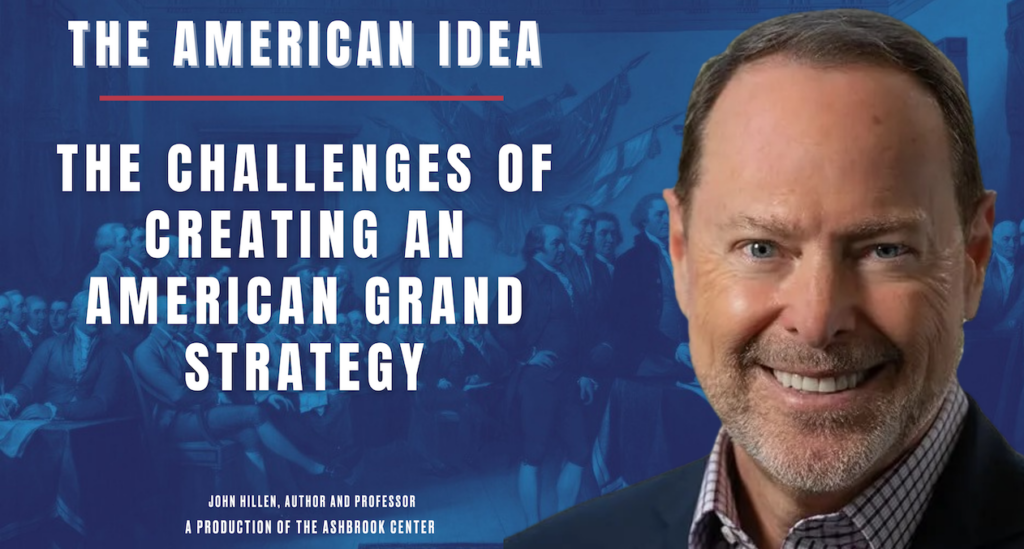The Challenges of Creating an American Grand Strategy
April 30, 2025

Listen and subscribe to the podcast
Join The American Idea’s Listener Email list – get news about upcoming episodes and a chance to offer questions for them, too!
American grand strategy—the overarching approach the United States takes toward its role in the world—has evolved dramatically since the nation’s founding. Unlike foreign policy, which refers to specific decisions and actions taken by the U.S. government to manage relations with other nations, grand strategy encompasses long-term goals that incorporate military, economic, cultural, and social resources, addressing both peacetime and wartime objectives.
Foundations: The Washington Doctrine
The founders’ vision for American grand strategy was shaped by their experiences with European power dynamics. After the Treaty of Paris in 1783 granted the new nation territory between the Appalachian Mountains and the Mississippi River, the United States became a westward-looking force. George Washington’s strategic vision established three enduring principles: forming a coherent domestic order, avoiding European entanglements, and pursuing westward expansion.
Washington stressed political unity and economic stability within the young republic while famously advising against involvement in European power struggles. These principles formed the foundation of American grand strategy through much of the 19th century, reflecting a balance between idealism and pragmatism that would characterize American strategic thinking for generations.
The Imperial Turn
The late 19th and early 20th centuries witnessed a dramatic shift in American grand strategy. Driven by economic interests and imperial aspirations, the United States began engaging more actively with the world. The McKinley and Roosevelt administrations embraced a more interventionist stance, participating in the Spanish-American War and asserting U.S. influence in places like the Philippines and Cuba.
However, American imperialism differed from European powers in its reluctance to fully engage in colonial conquest. While the Spanish-American War marked the nation’s first major step into global geopolitics, America sought to avoid the exploitative colonial practices of European powers. The U.S. advocated for an “Open Door” policy in China, ensuring equal access to trade, while resisting participation in the scramble for Africa.
American exceptionalism—the belief that the U.S. is unique in its values and destiny—served as a driving force behind this evolving grand strategy. The nation positioned itself as a beacon of democracy and freedom, guiding other nations toward these ideals. Even as American actions sometimes resembled imperialism, there remained a consistent reluctance to dominate or exploit other nations in the European manner. Instead, America often invested resources in territories and peoples, prioritizing humanitarian goals over exploitation.
World Wars and Global Leadership
The global conflicts of the 20th century fundamentally reshaped American grand strategy. Though the United States entered World War I later than most European powers, its involvement marked a significant shift toward global engagement. America’s military and economic power began to be felt on the world stage, though without pursuing traditional imperialistic goals.
During World War II, Roosevelt’s strategy rested on three pillars: prioritizing the European theater to defeat Nazi Germany, transforming America’s industrial base to produce war materials at unprecedented scale, and leveraging Allied resources—combining Soviet sacrifices, British resilience, and American industrial output—to achieve victory. By the war’s end, the U.S. controlled 85% of the world’s advanced manufacturing capacity.
The aftermath of World War II solidified the United States as the world’s dominant economic and military power. With the fall of European empires, America found itself uniquely positioned to influence global politics and shape post-war reconstruction. The nation evolved from its previous isolationism to become the primary defender of democracy and free markets.
The Cold War Strategic Mindset
In the Cold War era, American grand strategy shifted to focus on containing the spread of communism while leveraging economic strength. The United States pushed initiatives like the Marshall Plan and the Bretton Woods Agreement to rebuild war-torn Europe and prevent communist expansion. These efforts transformed former adversaries like Germany and Japan into key members of the global economic system.
Under Ronald Reagan’s administration, America adopted an economic-focused strategy to outpace the Soviet Union. Reagan believed that the free market and American innovation could undermine Soviet power—a calculation that ultimately contributed to the collapse of the Soviet Union.
Throughout this period, America maintained a significant global military presence, emphasizing military readiness, particularly with its Navy, which remained crucial for protecting global trade routes. As the world’s largest economy, the United States used its economic influence to shape global markets, pushing for free trade and democratic principles. Simultaneously, American culture spread globally through media, technology, and education, reinforcing its values and ideals.
Contemporary Challenges and Adaptation
After decades of relative strategic stability, American grand strategy now faces new challenges. The end of the Cold War and the rise of new global powers, particularly China, have prompted questions about whether the United States should continue its post-World War II approach or chart a new course.
The rise of authoritarian powers has created a competing strategic model. China, Russia, Iran, and North Korea have built unprecedented cooperation in economic, technological, military, and intelligence matters. This “authoritarian team” shares the goal of challenging American influence and expelling it from their regions. China has particularly focused on exerting soft power globally, using its growing economic and political influence to sway international opinion.
Today’s geopolitical environment is marked by competition between two broad strategic approaches: the liberal democratic system championed by the United States and the authoritarian model advocated by China and Russia. America faces the dual challenge of adapting its strategy to maintain dominance while managing new geopolitical realities.
Throughout its history, American grand strategy has reflected the nation’s core values and historical strengths. Whether through economic engagement or military might, the United States has repeatedly demonstrated that its grand strategy is both flexible and deeply tied to its values of freedom, democracy, and innovation. As global circumstances continue to evolve, America’s strategic approach will undoubtedly require further adaptation to address the changing world order.

